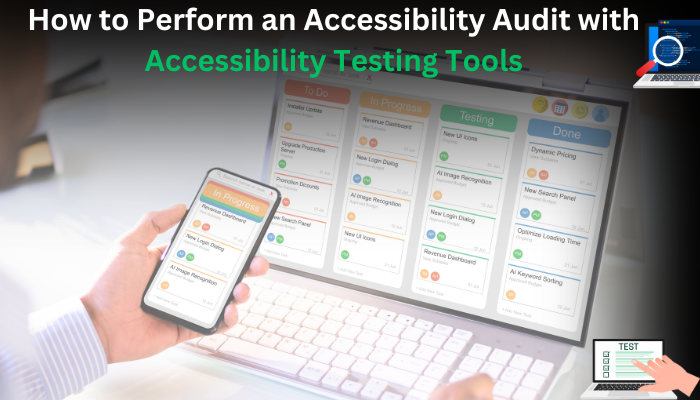Creating an inclusive digital experience isn’t just about compliance—it’s about ensuring that all users, regardless of ability, can navigate and interact with your website or application effectively. Performing an accessibility audit with accessibility testing tools is a structured way to identify and resolve barriers that might prevent people with disabilities from using your digital content.
This guide explores how to conduct a thorough audit using automated accessibility testing and other techniques to ensure compliance and usability.
1. Understanding Automated Accessibility Testing
Automated accessibility testing refers to the use of software tools that scan web pages or applications for accessibility issues. These tools analyze elements such as color contrast, alt text, keyboard navigation, and ARIA attributes to highlight potential barriers. While automation speeds up the process, it’s important to combine it with manual testing to ensure a comprehensive evaluation.
Key Benefits of Automated Accessibility Testing
- Quickly detects common accessibility issues.
- Ensures compliance with WCAG, ADA, and other standards.
- Reduces manual effort and speeds up the auditing process.
- Provides detailed reports for developers and stakeholders.
2. Selecting the Right Accessibility Testing Tools
A wide range of accessibility testing tools is available, each offering unique features to assist with audits. Choosing the right tools depends on the complexity of your website or application and the level of accessibility compliance required.
Popular Accessibility Testing Tools
- Axe DevTools: A browser extension that integrates seamlessly with development workflows.
- WAVE (Web Accessibility Evaluation Tool): Highlights issues visually on web pages.
- Lighthouse: Built into Chrome DevTools, providing automated accessibility reports.
- Tenon: Offers API-driven accessibility testing for developers.
- Pa11y: Open-source tool for continuous accessibility monitoring.
3. Running an Initial Accessibility Scan
Once the testing tool is selected, perform an initial scan by installing and configuring the tool in your development environment or browser. Enter the URL of the website or upload the web application for testing, then initiate the scan to generate a report identifying errors and warnings.
4. Conducting Manual Accessibility Testing
While automated accessibility testing identifies many issues, it cannot assess usability aspects such as:
- Logical focus order.
- Proper use of ARIA roles.
- User experience with assistive technologies.
Manual Testing Techniques
- Keyboard Navigation Testing: Navigate using only the keyboard (Tab, Shift+Tab, Enter, and Spacebar) to ensure all interactive elements are accessible.
- Screen Reader Testing: Use tools like NVDA, JAWS, or VoiceOver to experience how content is conveyed to users who rely on screen readers.
- Color Contrast Checks: Verify contrast levels manually, even if automated tools flag them as acceptable.
- Forms and Error Handling: Ensure form elements are labeled correctly and that error messages are accessible.
5. Evaluating WCAG Compliance
The Web Content Accessibility Guidelines (WCAG) serve as the global standard for web accessibility. Automated accessibility testing tools provide WCAG compliance scores, but understanding and interpreting these results is crucial for meaningful improvements.
WCAG Levels Explained
- A (Basic Accessibility): Addresses critical issues like keyboard navigation and text alternatives.
- AA (Standard Compliance): Ensures usability for most users, including color contrast and consistent navigation.
- AAA (Enhanced Compliance): Covers advanced accessibility features, often challenging to implement broadly.
6. Integrating Accessibility Testing into Development
To maintain accessibility, testing should be embedded into the development lifecycle rather than being a one-time audit.
Best Practices for Continuous Accessibility Testing
- Incorporate Testing in CI/CD Pipelines: Use tools like Axe and Pa11y to run automated tests during development.
- Train Development Teams: Educate developers and designers on accessibility best practices.
- Use Component Libraries: Adopt accessible design frameworks like Material UI or Bootstrap with built-in WCAG-compliant components.
- Conduct Regular Audits: Schedule periodic manual and automated audits to catch regressions.
7. Interpreting and Fixing Accessibility Issues
Use automated and manual testing insights to ensure compliance with WCAG 2.1 A, AA, and AAA levels, which are the global standards for web accessibility. Additionally, validate adherence to Section 508, which outlines U.S. government-mandated accessibility requirements, and ARIA (Accessible Rich Internet Applications), which enhances accessibility for dynamic web content.
8. Creating an Accessibility Report
Accessibility is an ongoing process. Implement continuous monitoring using accessibility linting in CI/CD pipelines to detect issues early. Schedule regular audits to track improvements and prevent regressions. Gather user feedback and conduct usability testing to validate real-world accessibility and ensure an inclusive experience for all users.
9. Monitoring and Maintaining Accessibility
Accessibility is an ongoing effort, not a one-time fix. Regular monitoring ensures that new updates do not introduce barriers.
Strategies for Long-Term Accessibility Maintenance
- Automated Scans on a Schedule: Run automated accessibility testing tools weekly or monthly.
- User Feedback Integration: Encourage users to report accessibility issues.
- Stay Updated on Accessibility Standards: Follow updates to WCAG and legal requirements.
- Internal Accessibility Champions: Designate team members to advocate for accessibility.
Read This Article Also – How Automated Accessibility Testing Boosts User Experience and Compliance
10. Final Thoughts
Performing an accessibility audit using accessibility testing tools is a fundamental step toward creating an inclusive web experience. Automated accessibility testing provides an efficient way to detect issues, but it should always be supplemented with manual reviews and real-user testing.
By integrating accessibility into your development workflow and maintaining ongoing monitoring, you ensure that all users, regardless of their abilities, can access and navigate your digital content seamlessly. Prioritizing accessibility is not just about compliance—it’s about fostering inclusivity and enhancing user experience for everyone.
To Read More Articles, Explore This Site – https://insidetechie.blog
 :
https://uk.pinterest.com/testevolve/
:
https://uk.pinterest.com/testevolve/












